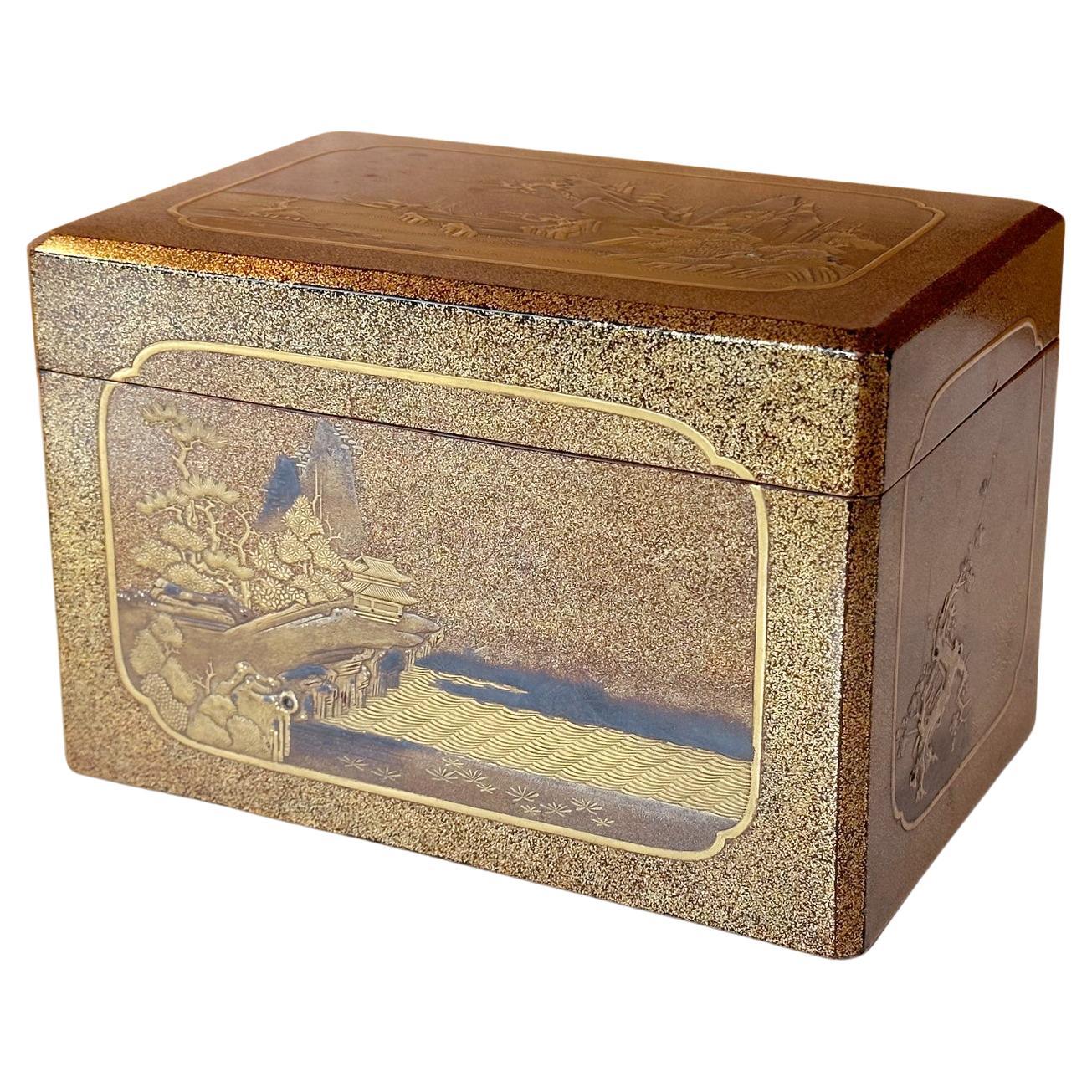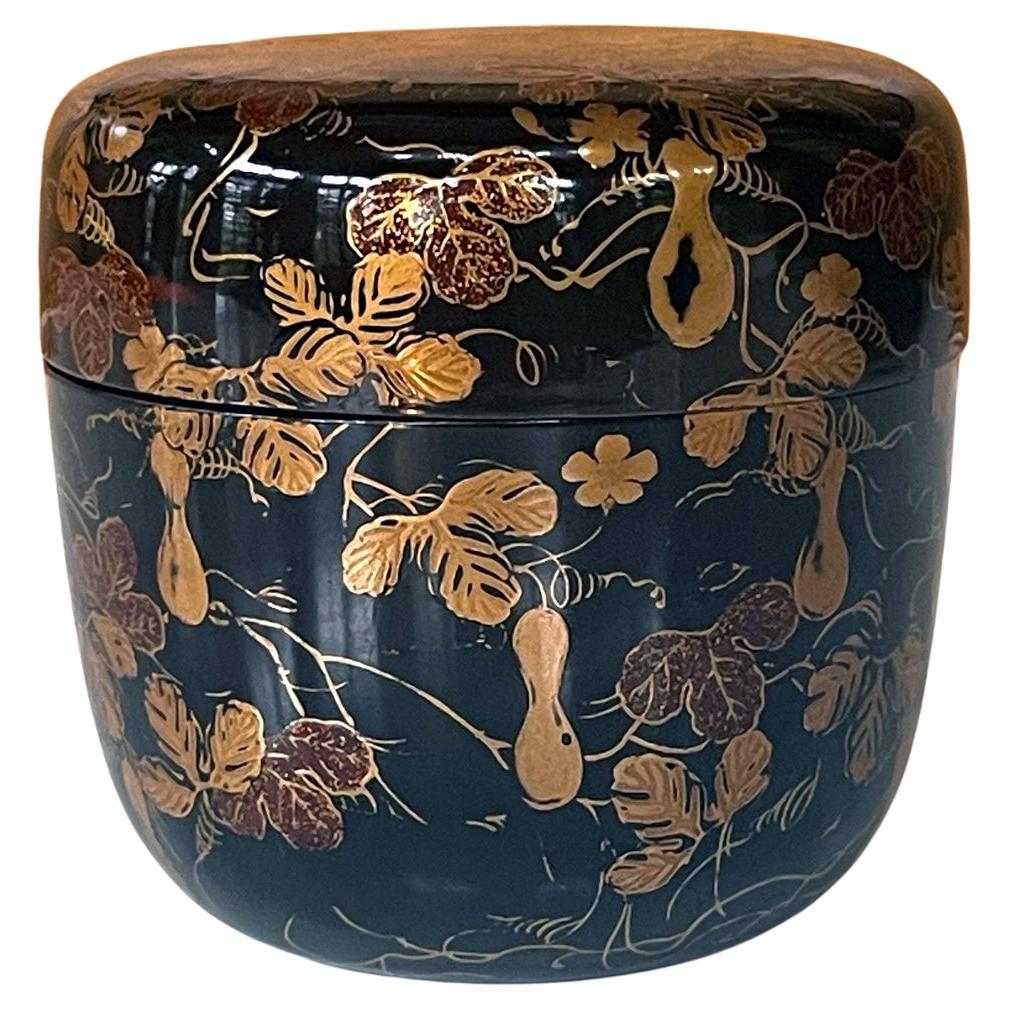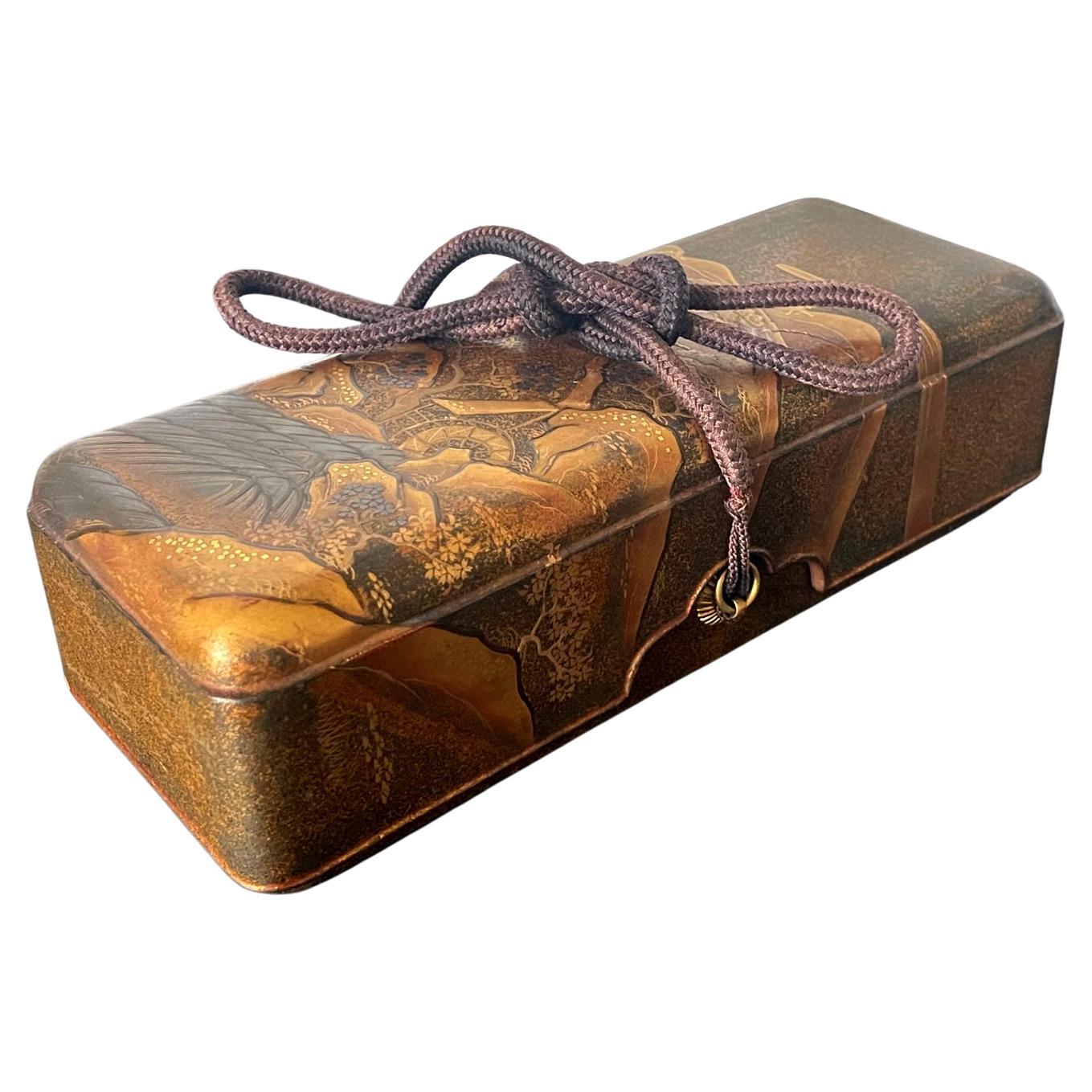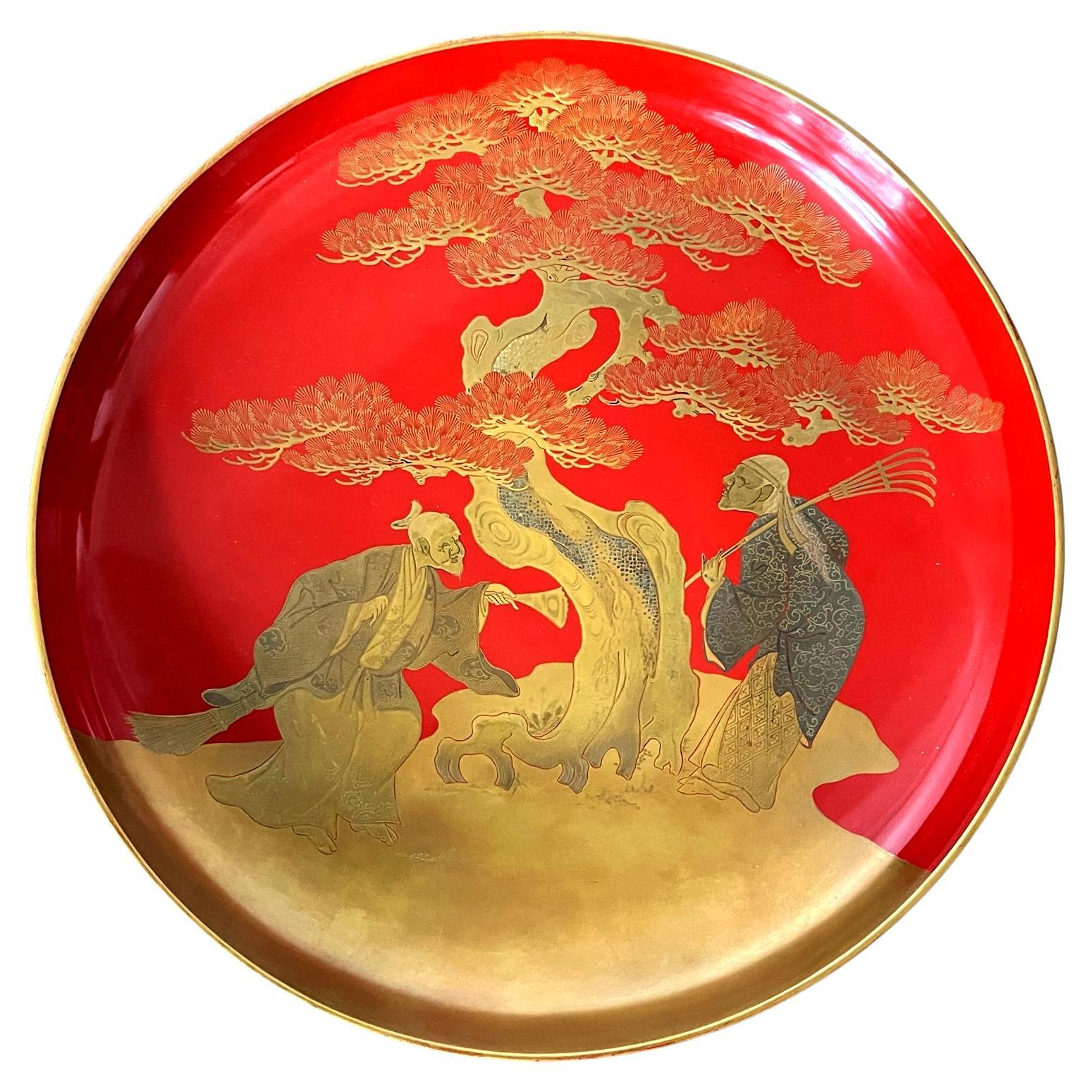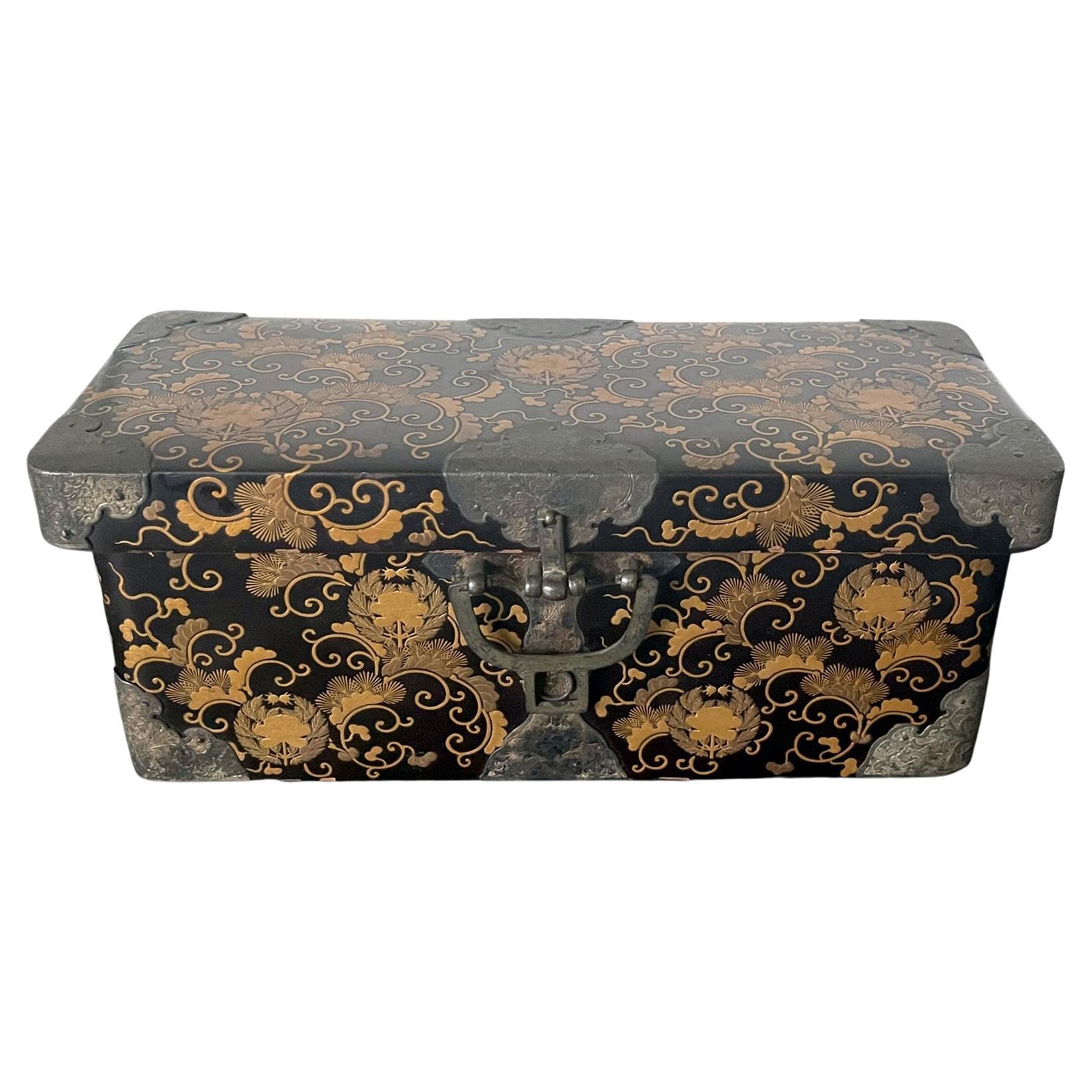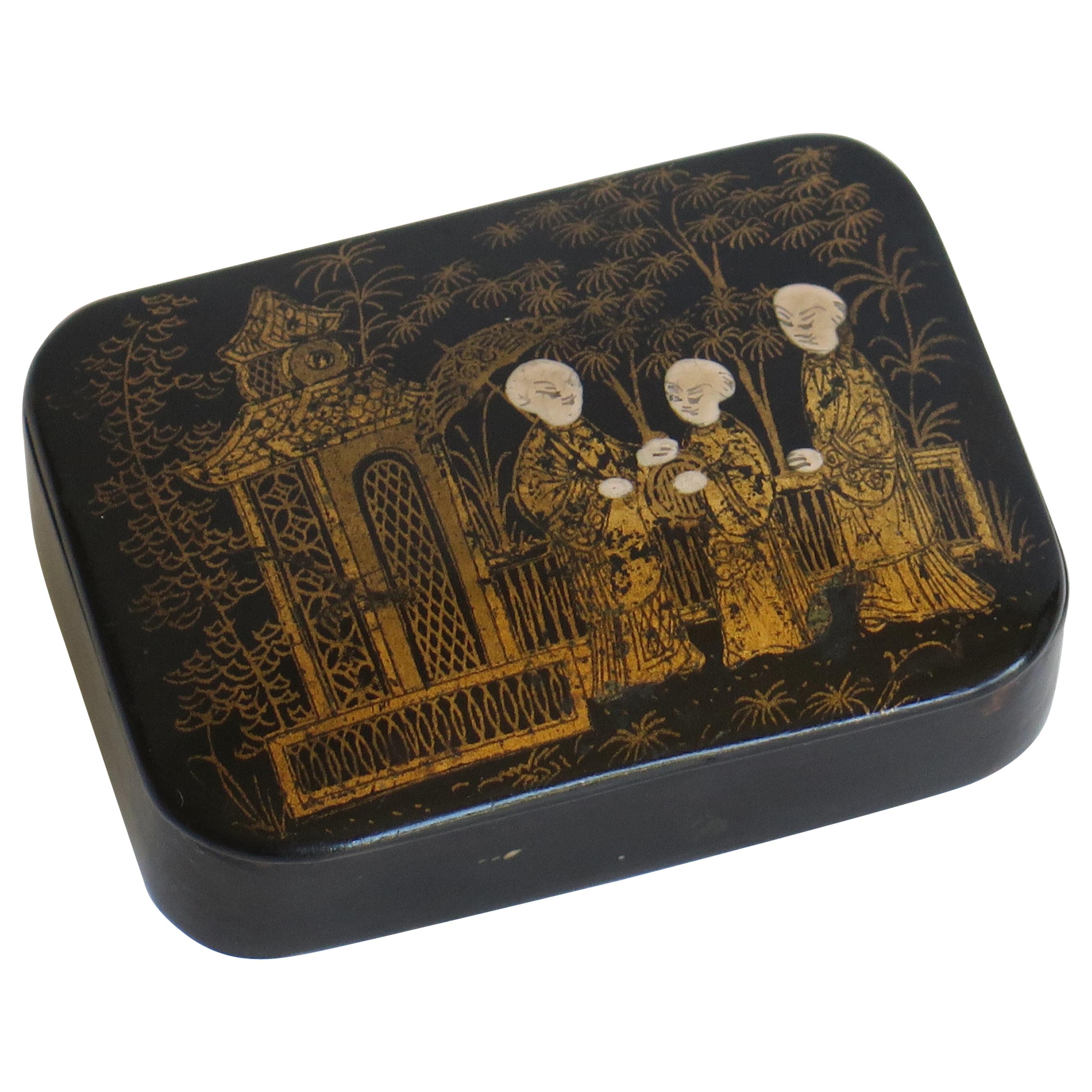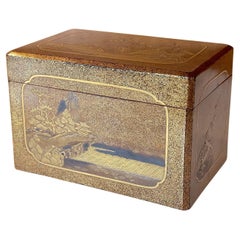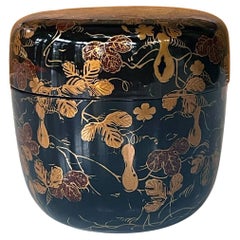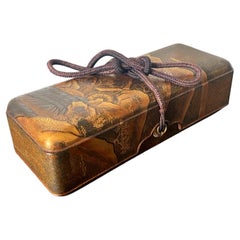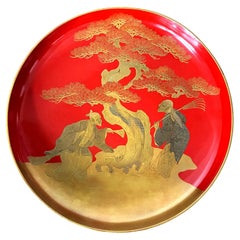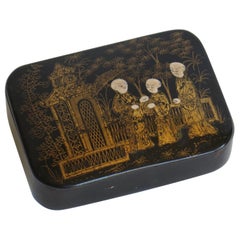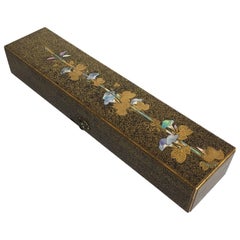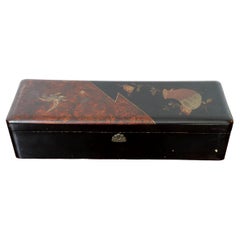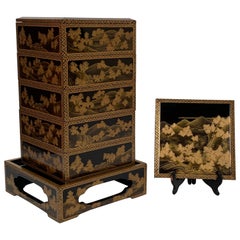Items Similar to Japanese Lacquer Maki-E Tiered Suzuribako and Ryoshibako
Want more images or videos?
Request additional images or videos from the seller
1 of 19
Japanese Lacquer Maki-E Tiered Suzuribako and Ryoshibako
$4,500
£3,384.95
€3,901.72
CA$6,338.75
A$6,955.12
CHF 3,639.98
MX$85,593.93
NOK 45,858.35
SEK 42,953.17
DKK 29,133.68
About the Item
A Japanese roiro lacquer scholar combo box with an upper tier of inkstone box (Suzuribako) and a lower document box (Ryoshibako) circa 1910-30s (end of Meiji to Showa period). The high glossy box was beautifully decorated with an image of the famously eccentric Buddhist monks Hanshan and Shide (known in Japan as Kanzan and Jittoku). Often as a pair, they have been a popular motif in Japanese Zen painting, representing deeper philosophical meanings and mysterious symbolism.
Hanshan or Kanzan ("Cold Mountain") and Shide or Jittoku ("found") were legendary Zen monks living in the Tang Dynasty (618–907) of China. The two close friends were often depicted as unconventional mystics, disheveled in appearance and mischievous in manners. Kanzan is identified by the pen and scroll he holds while Jittoku by a broom as he worked a kitchen cleaner. It was said that they communicated with a gibberish language only understood by them and were deemed lunatic and carefree. In Japan, starting in the Muromachi period (1336-1573), they were regarded by many scholars as the incarnations of Manjusri (Monju) and Samantabadhra (Fugen) and became a very popular motif in Zen Buddhism art.
The rendition of the two monks on the box cover is very similar to ink painting except that it was done in hiramaki-e technique. Confident, bold strokes and contrasting colors of gold and silver were used to create a slightly abstract illustration with depth and dimension. The faint forest in the background was executed in the Togidashi, the demanding technique achieved a desired misty and dreamy effect. The composition works very well with the contrasting techniques and together, they achieve a painterly quality on a different art medium.
The Suzuribako contains a suzuri (ink-stone) with fundame trim and a round cloisonne suiteki (water dropper) with wave design. While the exterior of the box is largely glossy black, the interior was rendered in contrast with texture of vertical ripple lines.
- Dimensions:Height: 4.125 in (10.48 cm)Width: 9.5 in (24.13 cm)Depth: 10.5 in (26.67 cm)
- Style:Meiji (Of the Period)
- Materials and Techniques:
- Place of Origin:
- Period:
- Date of Manufacture:1910-1930s
- Condition:Wear consistent with age and use. Good condition with minor shelf wear and a couple of surface scratches on the base. One corner of the lower box has a thin crackle line with possible touchup, not readily noticeable.
- Seller Location:Atlanta, GA
- Reference Number:1stDibs: LU945031292012
About the Seller
4.9
Platinum Seller
Premium sellers with a 4.7+ rating and 24-hour response times
Established in 2006
1stDibs seller since 2010
568 sales on 1stDibs
Typical response time: <1 hour
- ShippingRetrieving quote...Shipping from: Atlanta, GA
- Return Policy
Authenticity Guarantee
In the unlikely event there’s an issue with an item’s authenticity, contact us within 1 year for a full refund. DetailsMoney-Back Guarantee
If your item is not as described, is damaged in transit, or does not arrive, contact us within 7 days for a full refund. Details24-Hour Cancellation
You have a 24-hour grace period in which to reconsider your purchase, with no questions asked.Vetted Professional Sellers
Our world-class sellers must adhere to strict standards for service and quality, maintaining the integrity of our listings.Price-Match Guarantee
If you find that a seller listed the same item for a lower price elsewhere, we’ll match it.Trusted Global Delivery
Our best-in-class carrier network provides specialized shipping options worldwide, including custom delivery.More From This Seller
View AllExquisite Japanese Lacquer Maki-e Hand Box Kobako Edo Period
Located in Atlanta, GA
An early Japanese lacquer Maki-e decorated kobako (small storage box) circa 18th century (Edo period). Based on its form and size, this kobako was possibly used as a Chabako to store the accoutrements for chado (tea ceremony). The lidded box is of rectangular form with bevel design on all edge that softens the appearance. The entire surface was densely covered with a background of nashiji. Elaborate Maki-e techniques were used on each side to showcase a distinct landscape or floral design within a cartouche panel. On the surface of the lid, a mountainous landscape rises from the edge of the water. The poetic composition is akin to a traditional ink scroll...
Category
Antique 18th Century Japanese Edo Lacquer
Materials
Lacquer
Japanese Lacquered Maki-E Natsume in Kodaiji Style
Located in Atlanta, GA
A Japanese lacquered tea caddy (known as Natsume) with fine Maki-e decoration circa 18-19th century Edo to Meiji period. The large-sized nat...
Category
Antique 19th Century Japanese Meiji Lacquer
Materials
Wood, Lacquer
Japanese Lacquered Maki-e Fubako Edo Period
Located in Atlanta, GA
A Japanese lacquered wood fubako (a box used to store document or small scroll painting), circa second half of 19th century late Edo period. The rectangular box features an unusually deep lipped lid with slightly rounded corners, a conforming lower box that is almost entirely covered by the lid which has two bronze medallion rings with tasseled...
Category
Antique 19th Century Japanese Edo Lacquer
Materials
Wood, Lacquer
Japanese Lacquer Maki-e Plate of Takasago Story
Located in Atlanta, GA
A large circular plate with a short stem base in Vermillion lacquer color from Late Meiji Period circa end of 19th century to early 20th century. ...
Category
Antique 19th Century Japanese Meiji Lacquer
Materials
Lacquer
Japanese Antique Lacquer Maki-E Miniature Hasami-Bako with Copper Mounts
Located in Atlanta, GA
A Japanese lacquered box with lid in the shape of a miniature Hasami-Bako (traveling chest) circa late 18 to early 19th century of the Edo period....
Category
Antique Early 19th Century Japanese Japonisme Lacquer
Materials
Copper
Japanese Maki-e Lacquer Stack Box Jubako
Located in Atlanta, GA
An antique jubako (stack boxes) with five tiers in an elongated octagon shape circa 19th century (end of Edo or beginning of Meiji period). jubako was traditionally used to store and...
Category
Antique 19th Century Japanese Japonisme Lacquer
Materials
Wood, Lacquer
You May Also Like
Japanese Laquered Box with Hinged Lid hand painted, 19th Century Meiji Period
Located in Lincoln, Lincolnshire
This is a good papier mâché, rectangular shaped black lacquered lidded box, hand enamelled and gilded, made in Japan during the 19th century, early Meiji period.
This rectangular shaped papier mâché box has a well fitting hinged lid, with the box base and lid slightly domed. The box was probably originally made as a pocket box but could easily sit on a desk or dressing table as required.
This is a very decorative box with finely hand painted scenes of three people, one holding a parasol, in a garden setting, with a pagoda type building, large gate...
Category
Antique 19th Century Japanese Meiji Lacquer
Materials
Paper
Japanese Edo Period Igarashi School Long Lacquer Box, Tanzaku-Bako
Located in Austin, TX
A stunning Japanese Edo period lacquer tanzakubako, box for poem cards, late 18th-early 19th century, Edo Period, Japan.
Attributed to the Igarashi School, this box is masterfully ...
Category
Antique Early 19th Century Japanese Edo Lacquer
Materials
Mother-of-Pearl, Lacquer
Japanese Maki-e Lacquered Box, Ric.049
Located in Norton, MA
Japan, Edo to Meiji period, a long rectangular document box with hinged cover, decorated with a bird and a floral basket,
The locker is not functioning.
Category
Antique 19th Century Japanese Decorative Boxes
Materials
Lacquer
Japanese Maki-e Lacquer Stacking Box, Jubako, Meiji Period, Japan
Located in Austin, TX
A fine and impressive Japanese gold maki-e decorated black lacquer five-tier jubako with presentation tray, two lids, and the original tomobako storage box, Meiji period, late 19th c...
Category
Antique Late 19th Century Japanese Meiji Lacquer
Materials
Lacquer
Japanese Tagasode (Whose Sleeves?) Lacquer Incense Box, Kobako, Meiji Period
Located in Austin, TX
A fine and unusual Japanese lacquer box for incense accessories, kobako, featuring a tagasode (whose sleeves?) design, Meiji Period, circa 1900, Japan.
The exquisite box of simple rectangular shape worked in maki-e lacquer, taka-maki-e, and raden, all against a lush ground of gold nashiji. Fitted with silver rims.
The main decorative element of the box depicts a six panel folding screen, byobu, showing an interior scene with kimono strewn over a rack, a motif known as tagasode (whose sleeves), all in raised taka-maki-e lacquer and inlaid raden.
The screen depicts an intimate room with tatami mats on the floor and sliding shoji doors in the background. The foreground depicts a large clothing...
Category
Antique Early 1900s Japanese Meiji Lacquer
Materials
Silver
Japanese lacquer tebako 手箱 (box for personal accessories) with book design
Located in Amsterdam, NL
Superb rectangular black lacquer tebako (box for personal accessories) with a slightly domed well-fitted lid.
The lid has a continuous soft-tone multicoloured hiramaki-e (low-relief...
Category
Early 20th Century Japanese Lacquer
Materials
Lacquer
More Ways To Browse
Japanese Stone Art
Japanese Zen Furniture
Japanese Monk
Chinese Black And Gold Lacquered
Japanese Metal Box
Maki E
Silver Antique Japanese Boxes Silver Boxes
Antique Japanese Stone
Meiji Lacquer Box
Japanese Document Boxes
Antique Document Box
Japanese Cloisonne Box
Antique Ink Stone
Antique Broom
Japanese Mountain Scrolls
Meiji Cloisonne Boxes
Japanese Scholar Stone
Cloisonne Antique Chinese Boxes Cloisonne Boxes
